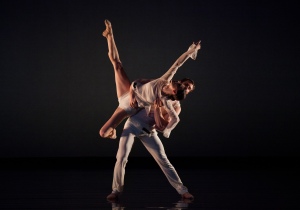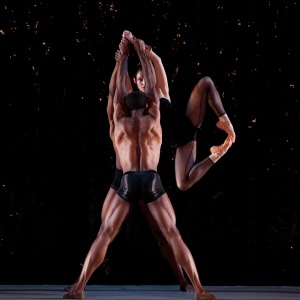The bi-city, 10-dancer, critically-acclaimed troupe that is Aspen Santa Fe Ballet (ASFB) returns to Chicago next Tuesday for one night at the Harris Theater. After a well-received debut here in 2007, ASFB couldn’t wait to come back as part of their 15th anniversary season. “When we were in Chicago for our debut, we’d never felt so welcome in a dance community,” says Artistic Director Tom Mossbrucker. “Chicago is one of the dance capitols of the world. There’s so much dance going on. We want to be a part of that.” Mossbrucker may be familiar to some. A former principal with Joffrey Ballet, he performed in over 70 ballets and toured extensively with the world-wide phenomenon Billboards and danced briefly with Hubbard Street. Now at the helm of ASFB (along with Executive Director Jean-Philippe Malaty), he cultivates an eclectic repertoire reminiscent of both companies that features William Forsyth, José Limón, Lar Lubovitch and Edwaard Liang, as well as actively pursuing newer choreographers and commissioning 24 ballets. “In the beginning, we didn’t have the budget for the big choreographers, so out of necessity, we started looking at new choreographers and it really served us well,” Mossbrucker says. “Neither Jean-Philippe or myself choreograph, so we sometimes say that’s the secret to our success.”
For the May 24th show, ASFB will perform three Chicago premieres. Jorma Elo‘s Red Sweet, Jirí Kylián‘s Stamping Ground and Nicolo Fonte‘s Where We Left Off. RB spoke with Mossbrucker, while the company was on tour recently in California.
RB: Your rep is really impressive. How do you decide what you’re going to present for the season?
TM: We’re always trying to look for something that’s forward-looking, something new…the next thing. That’s not easy to do. We do a lot of commissioned work. We were the first American company to commission Nicolo Fonte’s work. We loved his work. We were on the phone with him before the tape was even out of the machine. He was unknown and thrilled to come work with us. We developed this relationship with him and he kept coming back and doing more and more pieces for the company. In a way, he started to define the aesthetic of ASFB. He’s the first choreographer that we used that was interested in what was maybe a little more European-looking choreographers. After forming that relationship with him, we realized that was going to serve us well as a company to find newer choreographers and try to develop a relationship with them. The more choreography we did, the level of the company went higher and higher, so we felt it was a give-and-take. The choreographer got something from us, but we got something from the choreographer. In that exchange, we both nurtured each other at the same time.
RB: This is Nicolo’s eighth piece for the company. Can you tell me about his piece you will be doing here?
TM: It’s called Where We Left Off and I think the title refers to the fact that he’s worked with the company so many times. Each time he comes back, it’s very comforting for him and he can just pick up where he left off, so that title came very easily to him. There does tend to be a sort of dark, serious, edgy look to a lot of contemporary choreography and I think Nicolo wanted to take a departure from that and create a piece that was a little more hopeful. It just so happened that we had a lot of time to give him. We asked him to come out several months before and do a workshop. We wanted to give him the luxury to just experiment and see what happened rather than just say you have a few weeks to make a work and put it on stage. He came and worked with this abstract idea of hope. He went back home to NY and mulled it over. When he came back the second time to create the work, he basically started over. He took what he had done and completely changed it. He really took a much sharper turn that he expected and created what he says is a ballet just about dance and not about anything else. It’s about the joy of dance and beauty and joy and life. For him, that was a really big step and I think it took a lot of courage for him to just make it simple, no connotations, nothing edgy about it. It’s a really beautiful work. He used the entire company. You can completely see who Aspen Santa Fe Ballet is. It’s one of my favorite works by him.
RB: You’re doing your third Kylián piece. How did that relationship come about?
TM: When I was a dancer at the Joffrey, I danced several of his works and I remember it was just the most rewarding experience. As our company grew, it became important us to give the dancers exposure to some really great choreographers. Early on we did Balanchine and Tudor, Paul Taylor and we got our first Twyla Tharp ballet. As we looked forward, it was inevitable that we try to get a work by Kylián. We knew the audience would of course love it, but we thought the dancers had come to the level that they could do it and they should experience it.
RB: Your rep includes Petit Mort and Sechs Tanze, which Chicago audiences may be familiar with from seeing Hubbard Street, so can you tell me a little about Stamping Ground?
TM: Stamping Ground hasn’t been seen a lot in the States. It’s a very interesting work. It’s a different side of Kylián. It was inspired by the Aboriginal cultures. The first half (in silence) is solos for six dancers and each solo introduces the percussive sounds by stamping on the ground, slapping their bodies, you can hear their breath, so it starts to introduce to you the rhythmical patterns. Suddenly the music starts and the rest is this really intense percussive score. It also has elements of humor and poetry, like all his ballets do. It’s very tribal and animalistic, but also witty.
RB: And Jorma Elo’s piece?
TM: We were really excited about Jorma. I knew him as an acquaintance when he was still a dancer and I knew he was starting to choreograph. We had him early, so we were able to build a relationship with him. We were right before he hit it real big. He enjoyed working with the company. He enjoyed coming to Aspen. When we asked him back to do a second piece, he really worked to fit us in. The third work is Red Sweet. I think that this work really shows what can happen when you develop a relationship with a choreographer. When he can come back and know the company, know the dancers at a certain level, he can really bring out the strengths of those dancers. This has really become a signature work for us. He just captured the essence of each dancer. It’s vintage Jorma Elo. All of his great qualities come out in this. It’s very humorous, it’s quirky, it’s creative, it’s interesting.


